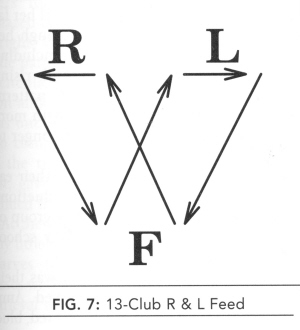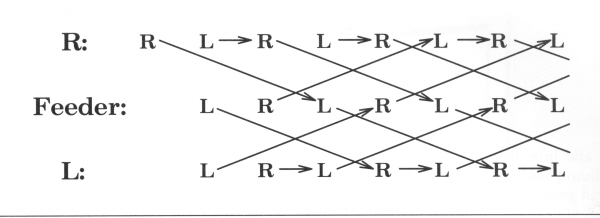|
Good
luck! If the 1-count is too hard, try a sort of alternating
1,3-count: pass, pass, self, self, pass, pass, self, self.
We
do odd counts in the star in order to avoid collisions. The odd counts
let us do normal star passes (right or left handed) through the
middle, and these passes stay away from the very center of the star,
where five clubs passing at the same time would collide for sure.
13-Club
R and L Feed For
you right and left numbers passers, here is a definite challenge ready
to be tamed. This is another 13-club feed, but it has only three
people. Based on the 11club right and left feed (Spring
1991 Juggler's Workshop), this has the exact speed of passing
eight clubs but the left hand
is also passing. Jimmy Robertson, Jim Hugunin and I worked a
little on this at the Burlington festival and had some good, though
short, runs. Jon Held was watching and called this the most
chaotic-looking pattern he'd ever seen - and that was when it was
working.
If
you're into ball passing, try this pattern with balls, as that should
be much easier than with clubs but still a lot of fun (and with balls
you can easily make the heights whatever you want).
With
clubs, you can do this feed with either triples, doubles or singles.
The speed will be that of passing eight triples, eight doubles or
eight singles, respectively, but one person will be passing left
handed and the feeder will be passing with both hands. If two of your
three jugglers can throw good left hand triples, try the pattern with
triples; like eight triples, it won't be terribly fast. Doubles will
be easier to control, but faster. Singles will be downright swift.
The
feeder passes with both hands, and the feedees pass with one hand (one
right, one left). The feeder passes right handed to the feedee on the
left (who passes right handed) and left handed to the feedee on the
right (who passes left handed) as shown in Fig. 7.
Although
there are other ways to start, I prefer to have the right handed feedee
starts with five clubs, as if starting nine, while the others start with
four (two in each hand). The right handed feedee passes first, and the
feeder and the other feedee exchange left hand passes one count later.
The feeder then exchanges R passes with the first feedee while the
second feedee does a self. Then start over.
Fig.
8 shows the causal diagram for the 13-club feed, whether you're passing
triples, doubles or singles. Note that everyone's R hands are in sync,
as of course are the L hands.
To
slow the pattern down a little from pure doubles without everyone having
to If
you have any comments or suggestions |

